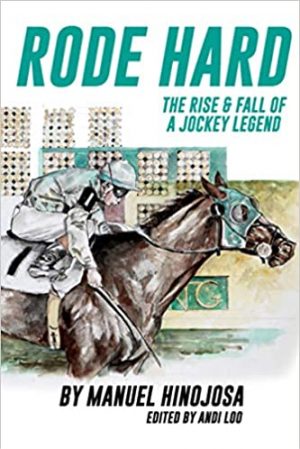A biography by Manuel Hinojosa
Book Review by Chuy Ramirez
For a biography to remain interesting and engaging, it must tell a great story. A good biographer exercises reasonable discretion in painting a portrait of her subject. But for the biography to remain legitimate, the story-telling must be consistent with historical fact. As a sports historian and enthusiast, Manuel Hinojosa was dedicated to telling a great sports story of a great horse jockey—Herbie Hinojosa (no relation). Herbie amassed a record number of horse race wins and earnings during his career which spanned some 40 years. M. Hinojosa set especially high standards for assuring that the story-telling was consistent with the facts. An architect by profession whose upbringing had absolutely nothing to do with horses or horse racing, Hinojosa had to learn about the business and sport of horsing racing, and in particular, quarter-horse and thoroughbred horse racing during the decade he spent interviewing Herbie.[1] Through endless interviews of his biographical subject — the diminutive Herbie Hinojosa—the historian developed an insight into and great respect for this athlete.
Herbie Hinojosa was indeed an iconic athlete in the mode of the best of them and it is difficult to imagine that anyone other than M. Hinojosa could have told Herbie’s story with the single-mindedness zeal and attention to detail which M. Hinojosa brought to bear on the story. And so, while Rode Hard is a great story, and keeps the reader excited and engaged, it also represents a decade’s worth of meticulous fact-finding relying on primary sources. To boot, M. Hinojosa could not have found a more supportive editor than his daughter, Andi Loo, whose job it was to distill years of M. Hinojosa’s notes and tapes of interviews with Herbie into a final, well-written book.
To tell Herbie’s story truthfully, amateur archeologist Hinojosa was required to dig in unexcavated ground. But his search would take place in endless leads in sports newspapers of the 1950s and 60s. The artifacts he would find– sports articles, photos, record of wins and earnings—would confirm what had seemed unbelievable anecdotes which Herbie would share with M. Hinojosa over endless evenings. Yes, Herbie had won all those quarter-horse races at Santa Anita and Ruidoso Downs and thoroughbred races at the Preakness and Belmont. Over Herbie’s career, he had 25,160 starts, winning 3,334, and seen some $17 million in burn through his pockets. Gone where? Herbie could only respond that he had no regrets for the life he led as a successful horse jockey. In fact, he had given one of his son’s, Chuckie, to it. Chuck died in 1985 at the age of 24 at the Charles Town Race Court in Charles Town, West Virginia, from injuries he received in a pile-up during a race.[2]
Herbie had thoroughly enjoyed his sport, he told his biographer. Indeed, Rode Hard is replete with Herbie’s escapades once he became successful and a celebrated jockey. He played cards with movie stars and even dated some of them; he drove the luxury cars. Yet, when Herbie died in Brownsville, Texas at the age of 83, he could not even afford the cost of a burial. His biographer, and last great friend, M. Hinojosa, would cover the cost. And that is as it should be in any great story.
[1] Quarter horse racing, a linear race for a quarter mile between two horses, has been common in Northern Mexico and South Texas for centuries. Spanish language movie-goers of the past four decades are generally familiar with quarter mile races in the movies of Antonio Aguilar in which horses are memorialized with ballads about their feats. Many a Mexican ballad features a memorable horse: la llegua colorada, el potro lobo gateo, el Cordillo, Caballo Prieto Azabache, Cabayo Bayo. Thoroughbreds are larger and stronger than quarter horses and race for between 1 and 1 ½ miles.
[2] Bradley, John Ed, A Jockey Mourned, https:/www.washingtonpost.com/archive/sports/1985/ July 26, 1985.




